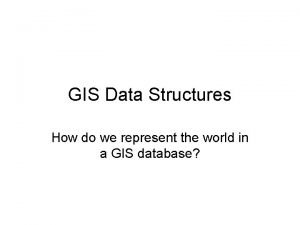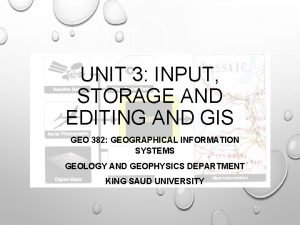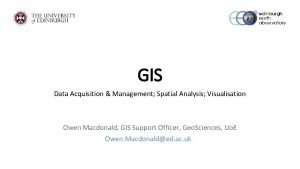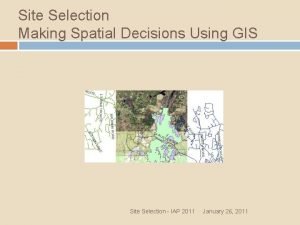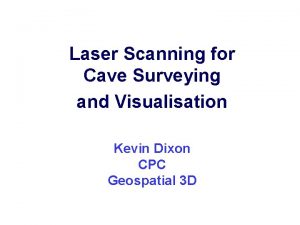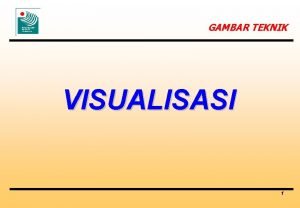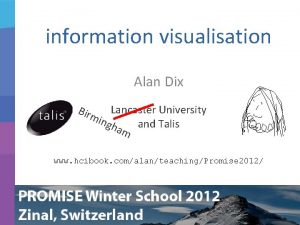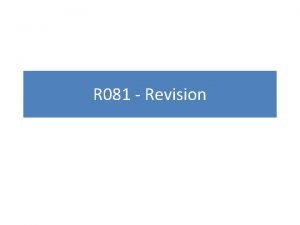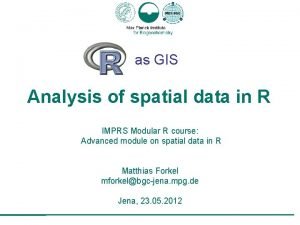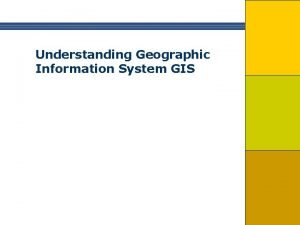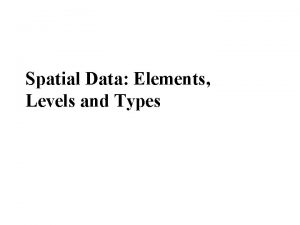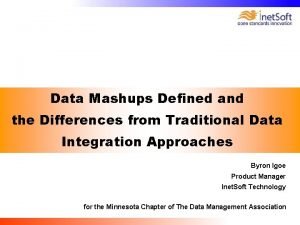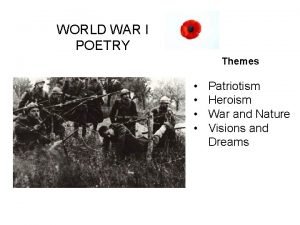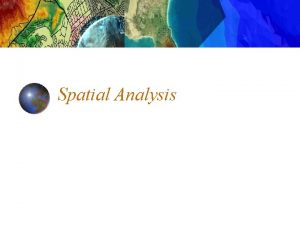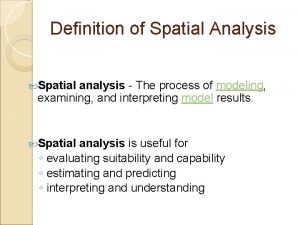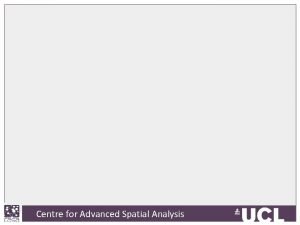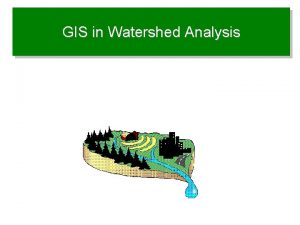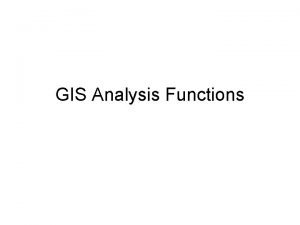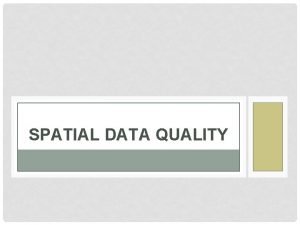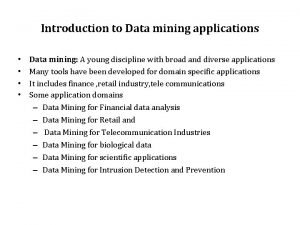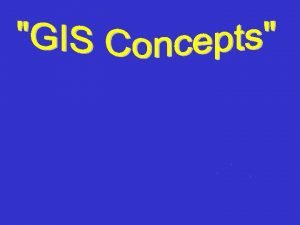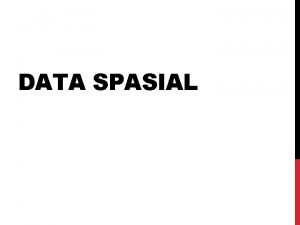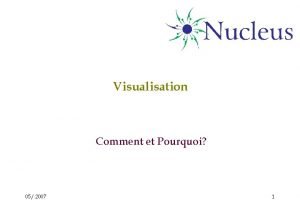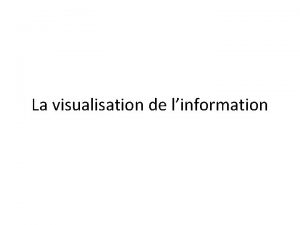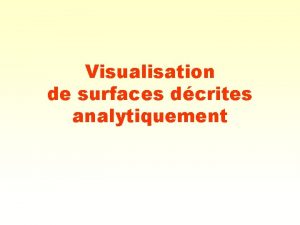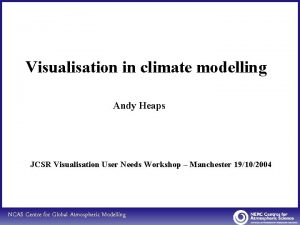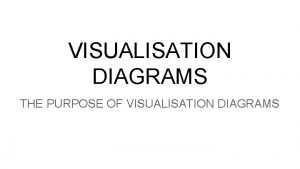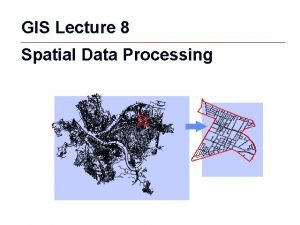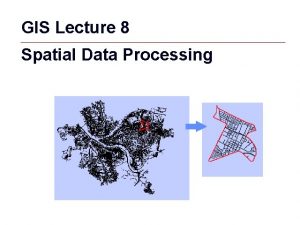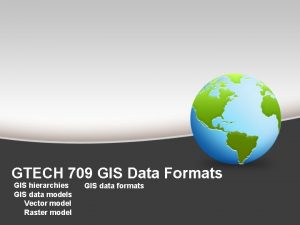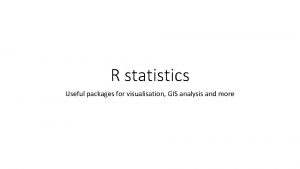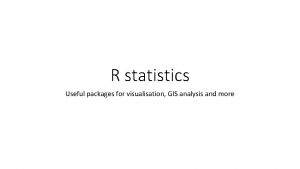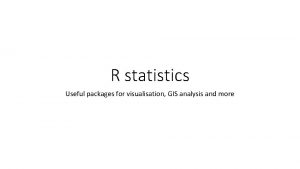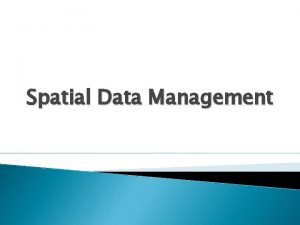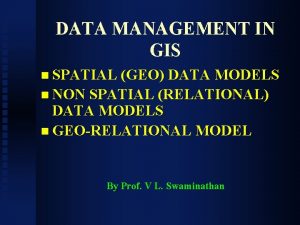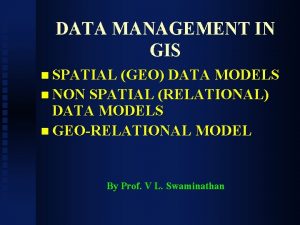GIS Data Acquisition Management Spatial Analysis Visualisation Owen








































- Slides: 40

GIS Data Acquisition & Management; Spatial Analysis; Visualisation Owen Macdonald, GIS Support Officer, Geo. Sciences, Uo. E Owen. Macdonald@ed. ac. uk

Outline • Background/Basics • The Everyday – What do you need? Desktop Package or Web Map? • Visualisation – GIS Limitations/Novel Techniques

Background/Basics Quick Intro to GIS

What is GIS? • Geographical Information System…GI Science (Poss. rebrand: Spatial Data Science) • Conceptualising reality in a computer model • Underpinned by spatial analysis; more than just maps or manipulation • Why is GI important? • Everything happens somewhere • Ability to attach multitude of information to locations/geography units • Relationships between phenomena/variables • spatial coincidence • relate/transfer info (attributes) between layers where these coincide

GIS Workflow • Data acquisition/integration • Data management/database management • Data analysis/Spatial Analysis • Cartography/Visualisation

GIS Functionality • Data acquisition/integration • (Scan and) digitise • Tabular Data with Spatial Location (Point or Centroid); or can join to other located data/geography units • GPS/Survey/Laser Scanning/LAS/Point-Clouds • Aerial/Satellite Image • Data management/database management • • • Storage Editing Metadata (describe datasets meaningfully and in terms of quality/coverage) Indexing (speed up data retrieval) Map Projections – in here as apply to both analysis and visuals…

GIS Functionality • Data analysis/Spatial Analysis – Map 'Layers' (Layer Stack); Spatial Co-incidence of layers • • Querying; Select by Attributes; Select By Spatial Location; Proximity Analysis/Buffering Overlay/Intersect etc. Interpolation of irregularly spaced data/sample points Spatial Statistics – point patterns, hotspots/clustering, spatial autocorrelation Scale/Aggregation/Zonation issues – MAUP, spatial autocorrelation, areal interp, dasymetric map Spatial is 'a bit' special – but can apply various techniques above to any 2 D/3 D 'space' Decision making • Cartography/Visualisation • • • Display new computed variables/statistics Mostly 2 D though long-record of 3 D/4 D research; Novel techniques to present complex info in 2 D; ESDA; 'new' field of Visual Analytics 3 D GIS emerging (traditionally '2. 5 D') Decision making; Interpretation

Data Models and Types • Essentially two common models of space • Discrete Entity • Continuous Field • Discrete Entity (== Vector Types) • Objects exist with empty space in-between • Modelled in GIS by Vector data types/structures – points, lines, polygons • Continuous Field (== Raster Types) • Continuous grid of raster cells, each has a value for a single variable of interest • Empty space explicitly represented by No. Data (cf. NULL) cells, within grid extent

Data Types: Vector • Discrete entities with specific locations; empty space between • Multiple attributes for each feature Point Polyline Polygon Geographical Information Systems: Principles, Techniques, Management and Applications, 2 nd Edition, Abridged Introduction (P A Longley, M F Goodchild, D J Maguire, and D W Rhind). : 77.

Data Types: Raster • Continuous surface with changing values; 'empty' No. Data cells where req’d • • Elevation and derivatives Satellite imagery Photographs Scanned maps • Attributes • Each cell has single value • This can relate to Value Attributes – NB attributes of the value held by the cell, not the cell itself nor its spatial location!

From ESRI Map Book Volume 24, www. esri. com

Other Model/Data Types • Firstly, there are some other model frameworks/types: • Triangular Irregular Networks TINs ('vector surface'!); variable res’n across surface • Also ESRI (Arc. GIS) specific – Terrains, Multipatches; 2 D-3 D interface • However: • Built from points (TINs), and lines, polygons, groups of points, large point-clouds • Also: Other Data Formats • Binary Formats – handle large data volumes, compact size • Multidimensional data – Net. CDF

Open GIS – Formats, Apps, Data • Open Standards / Formats – Open Geospatial Consortium (OGC) • • GML; City. GML(3 D); KML (GE); Geo. JSON (Java. Script - NB Geo. JSON not maintained by OGC) Moving Features Net. CDF WMS; WMTS; WFS • Open. Source Applications – Open Source Geo. Spatial Foundation (OSGeo) • QGIS/GRASS (use GRASS in QGIS; QGIS plugins; extend with Python) • gv. SIG/u. Dig (former extensible/mobile; latter Java/Eclipse based) • RDBMS+Spatial Extensions – e. g. Postgres with Post. GIS extensions (also pg. Routing) • Open. Data • OS Open. Data (since 2010); Also extra OS/other data avail to HE via EDINA Digimap • Open. Street. Map (linked to likes of Open. Layers/Leaflet etc. ) – VGI (Volunteered GI) • Also traditionally ‘open’ providers: Natural Earth, USGS

Changes in GIS • Server GIS • Dumb-terminal connects to a server (possibly in same building) • Desktop GIS • Typical standalone full GIS package on desktop PC (e. g. Arc. GIS, Quantum GIS/QGIS) • Web GIS / Distributed GIS • Online processing services, Web Map/Feature Services, Remote Servers • Client-Side Web GIS • Thin or Thick Client, GIS in your web browser, Java. Script, Arc. GIS Online • Mobile GIS • GIS on your tablet/phone/PDA – Arc. Pad, gv. SIG • Ubiquitous GIS • Sensor Networks, GPS Trackers, Location Based Services, Geo-aware APIs

Everyday GIS What do you actually need?

Everyday GIS on your PC – Different Levels of 'GIS' • Do you really need 'Desktop'? – Ignorance of Arc. GIS no longer a crime! • • Google Maps Google Earth/Arc. Globe (KML/KML Timestamp) (Spatial) Database – render on webpage in SVG Need better SQL querying? – Store in Database: Oracle/Oracle Spatial, Postgres/Post. GIS Connect GIS to DBMS; Also connect R/stats package to GIS/Database Do all in R? Python? • Can access Arc. GIS/QGIS codebase directly without GUI performance issues • Or, mapplotlib basemap, Py. SAL – ESDA • Do you need more (specialist) than Desktop? – We’ll look at these later… • Arc. GIS Server/New Arc. GIS Pro (integrated 2 D 3 D environment) • ESDA – Geo. Da, CAST, Py. SAL – again perhaps R? • Crime Analysis - Crime. Stat

GIS in your Browser • Google Maps • Even simple click+create maps (but now may require some degree of login – My. Maps) Or can run a web script, e. g. : • Generates a KML doc and returns: • • URL to KML Google Maps URL to KML User decides which 'viewer' to use Allows for poor internet connections

GIS in your Browser • Or can use Java. Script and GM API within a web page using a map 'object' • HTML+Java. Script • Code to produce example image shown, is included below • Can add placemarks etc. to Java. Script (and thus map) • Mashup (verb. ) whole datasets on top of e. g. Google! Weather, Photos, Locations…

Map Mashups • Java. Script-powered web pages can also use HTML Forms to retrieve user input: • Co-ordinates • Origin/Destination Postcode • URLs built using web map sites’ APIs e. g. • www. streetmap. co. uk/newmap. srf? x=3210 00&y=621000&z&ar=n • Hit Go! and returned are one, or more, geo web pages: • Maps • Routing (e. g. Multimap, Google)

Map Mashups • Java. Script-powered web pages can also use HTML Forms to retrieve user input: • Co-ordinates • Origin/Destination Postcode • URLs built using web map sites’ APIs e. g. • www. streetmap. co. uk/newmap. srf? x=3210 00&y=621000&z&ar=n • Hit Go! and returned are one, or more, geo web pages: • Maps • Routing (e. g. Multimap, Google)

Map Mashups • Java. Script-powered web pages can also use HTML Forms to retrieve user input: • Co-ordinates • Origin/Destination Postcode • URLs built using web map sites’ APIs e. g. • www. streetmap. co. uk/newmap. srf? x=3210 00&y=621000&z&ar=n • Hit Go! and returned are one, or more, geo web pages: • Maps • Routing (e. g. Multimap, Google)

Open Alternatives • Javascript Map Libraries • • Open. Layers Leaflet Map. Box JS (built-on Leaflet) Arc. GIS API for JS (…Arc. GIS Online) • Map. Tiler – create hierarchical sets of map images for rapid display/zoom • Map. Server • Geo. Server • Map. Box • • Hosting – cf. Arc. GIS Online Mapnik – Develop desktop/web apps Tile. Mill – apps (built-on Mapnik) Arc 2 Earth – Arc. GIS published to Map. Box • NB Arc 2 Earth puts Google Maps in Arc. GIS! • Quantum GIS Server

Cloud GIS; GIS Apps • Arc. GIS Online (Cloud GIS) • • Login Hosting ESRI Desktop/Mobile Apps Arc. GIS Marketplace (incl. RS images 'through the cloud'!) • Other Apps/Marketplaces • Auto. CAD • Maths/Diagramming Tools • Arc. GIS Apps Including: • ESRI Business Apps • Where does one begin? • NB Arc. GIS for Developers acc’t – free!! • Map and 3 D Scene Viewers (Web) • Collector (Android Jan, i. OS Mar) • Explorer (Android, i. OS, Mac!!) • Maps for Office • Maps for Share. Point

Visualisation GIS Limitations / Novel (or newly implemented) Techniques

Cartographic Principles • Still apply… • • • Colour Theory Map Purpose Necessary (or unnecessary map marginalia – N arrow, scale bar or text? Etc. ) Colours or shading (changing hue or increasing intensity) Clarity/avoid Map Clutter (not overloaded, cf. Power. Point slides - ahem!) • But also IT concepts to consider… • Symbol type/style/size – e. g. halo effects to make stand out/legible • Label placement/collision detection rules • Image Resolution – end use? (web or print? )

Beyond 2 D: 2. 5 D, Not quite 3 D • Historically used in computer games • Appearance of 3 D world (e. g. buildings, extruded shapes) but movement constrained to XY plane (2 D) • Use of camera angle/projection and/or e. g. scaling of height to give depth perception also parallax scrolling and texture mapping and other effects Image: Lin. City / Wikimedia Commons / GPL

Beyond 2 D: 2. 5 D, Not quite 3 D • In GIS to date a 2. 5 D surface occupies 3 D space but still an XY plane at any point. • Each XY location in a layer will have one unique zvalue (height) • Heights obtained from a related DEM raster or from values stored in either data geometry (zvalues) or attribute table field • Extrusion and offset of layers possible • Discontinuities not modelled (functional surfaces only) – so no use for vertical geological faults (i. e. dip = 0 degrees) • May be possible in some open source GIS – e. g. GRASS r. plane? ? Contains OS data © Crown copyright and database right 2015

Beyond 2 D: 2. 5 D, Not quite 3 D • We can however perform 3 D analysis: • • Viewshed/visibility analysis Visual Impact/Skylines Building shadow, amount of sunlight Amount of internal space overlooked • ESRI also offer multipatches (outline of 3 D shapes and texture mapping) for some 3 D work – close, but? … Contains OS data © Crown copyright and database right 2015 • Watch this space…

Globe Viewers – 3 D? • ESRI Arc. Globe • Reprojects all layers to one CRS • Arc. Reader (Free basic ‘reader’) • Explorer for Arc. GIS (…Online, basic!) • Arc. GIS Explorer Desktop (Free!) • Lets you switch quickly 2 D<->3 D! Images: ESRI

Globe Viewers – 3 D? • Google Earth • Subsurface? • Surface discontinuities? Image via Google Earth plugin demos • Thematicmapping. org – B. Sandvik • KML produced, symbolising datasets • 1 D (bar length), 2 D, or 3 D symbols

Global Thematic Mapping • Can use GE or GE plugin • GE plugin may face extinction (beware ‘Google pulling the rug’) • Which might mean the end of many sites built-on GE https: //youtu. be/t 0 L 9 co. Owk. E 8 • • Flight trackers – “Follow in GE” Ship trackers – “View in GE” E. g. Google Earth Flight Simulator! http: //www. gefs-online. com/

Map projections / Co-ord Ref Systems (CRS) • Geographic Systems – curved Earth, angular units vs. Projected Systems – flat Earth, linear units • Important to understand basics – though not always critical to define/set CRS for all layers if working in one coord system and correct units/extent values seen – be able to spot if wrong! • However, if you have data based on multiple Earth surface models then you must ensure you specify the correct datum. GIS offers on-fly transformation between datums but layers in angular units will need projected to new data layer to match up exactly. • Get the datum right – what the data are in (e. g. GPS in WGS 84 geo), then project as req’d e. g. BNG • No unique lat, long for every point on Earth – depends on datum/geographic CRS used • Also becomes more critical when working with e. g. Globe Viewers where all layers are projected to e. g. Cubic projection! With Arc. Globe all layers must have a CRS defined. • Also bear in mind peculiarities of different projections. • Distortion – of familiar shape? area/proportion of map occupied? angular relationships? • Web Mercator / Web Maps incl. Google – Distortion far from equator, Scale change with latitude!

Interactive Cartography – ESDA • ESDA – Exploratory Spatial Data Analysis • Geo. Da/CAST/Py. SAL • Brushing & Linking • Explore Feature/Data/Stats Space & • Explore Real Space (simultaneously) • • 2 D Cartogram 3 D Box Plot Parallel Coordinate Plot Others…

Interactive Cartography – ESDA • ESDA – Exploratory Spatial Data Analysis • Geo. Da/CAST/Py. SAL • Brushing & Linking • Explore Feature/Data/Stats Space & • Explore Real Space (simultaneously) • • 2 D Cartogram 3 D Box Plot Parallel Coordinate Plot Others…

Interactive Cartography – ESDA • ESDA – Exploratory Spatial Data Analysis • Geo. Da/CAST/Py. SAL • Brushing & Linking • Explore Feature/Data/Stats Space & • Explore Real Space (simultaneously) • • 2 D Cartogram 3 D Box Plot Parallel Coordinate Plot Others…

Interactive Cartography – ESDA • ESDA – Exploratory Spatial Data Analysis • Geo. Da/CAST/Py. SAL • Brushing & Linking • Explore Feature/Data/Stats Space & • Explore Real Space (simultaneously) • • 2 D Cartogram 3 D Box Plot Parallel Coordinate Plot Others…

Interactive Cartography – VA • (Geo. Spatial) Visual Analytics • Geo. Vis -> Geo. VA? • May well include some existing types of analysis… • ESRI adopted 'analytics' in place of 'analysis‘! • Big in London in partic – CASA, gi. Centre at City • Plus Map. Tube, http: //spatial. ly/, London data/vis e. g. TFL, Crime • Use of linked views cf. Geo. Da/ESDA • 'Processing' (noun) prog. language for visuals, often used

Visualising Movement/Flows • Big Data(sets) • Twitter Feeds • APIs/Screenscraping • Smart Cities • Crowd-sourcing/VGI https: //www. youtube. com/watch? v=r. JC 7 B-9 Zfh. E

A Few 100(0) Other Things to Explore… • • • Tobler’s 1 st Law Topology Network / Metro maps… Database Theory / Best Practice Modern Databases (No. SQL!) Spatial Data Infrastructures (SDI) Spatial Regression/Error Modelling Metadata (Standards) Quirks of ESRI File Formats! Arc. GIS Quirks… Evolution of GIS – why it is the way it is… • • Human Computer Interaction User Needs Testing; Accessibilty Issues User Perception/Psychology Deeper Information Theory • User/Software Behaviour • Display of Info (Bertin) • Visualisation Luminaries • Tufte, Mac. Eachren, modern-days • Automated Carto / Map Generalisation • Heat Mapping • Space Time Cubes / Temporal GIS

…But never* be afraid to ask! Question Time? *See: Advice to the Aspiring Interactive Cartographer. . . http: //www. axismaps. com/blog/2012/09/advice-to-the-aspiring-interactive-cartographer/
 Oflinemaps
Oflinemaps Gis data structure types
Gis data structure types Spatial data editing in gis
Spatial data editing in gis Spatial data acquisition
Spatial data acquisition Spatial data acquisition
Spatial data acquisition Data acquisition and data analysis
Data acquisition and data analysis Making spatial decisions using gis
Making spatial decisions using gis Monitor model
Monitor model Pre production visualisation diagram
Pre production visualisation diagram Total station visualisation
Total station visualisation Apa itu visualisasi gambar
Apa itu visualisasi gambar Bread crumb polychromatic lustre in complicated cataract
Bread crumb polychromatic lustre in complicated cataract Mona chalabi charts
Mona chalabi charts Visualisation
Visualisation Visualisation
Visualisation R081 revision
R081 revision R for gis
R for gis Spatial data and attribute data
Spatial data and attribute data Spatial data and attribute data
Spatial data and attribute data Enterprise data mashup
Enterprise data mashup Data mashups and gis are data integration technologies.
Data mashups and gis are data integration technologies. What is data acquisition in data warehouse
What is data acquisition in data warehouse World war 1 poetry wilfred owen
World war 1 poetry wilfred owen The next war poem
The next war poem Futility wilfred owen summary
Futility wilfred owen summary Dulce et decorum est tone
Dulce et decorum est tone Wilfred owen the chances
Wilfred owen the chances Futility wilfred owen analysis line by line shmoop
Futility wilfred owen analysis line by line shmoop Anthem for doomed youth
Anthem for doomed youth Owen dulce et decorum est analysis
Owen dulce et decorum est analysis Spatial analysis questions
Spatial analysis questions Spatial analysis meaning
Spatial analysis meaning Spatial design network analysis
Spatial design network analysis Centre for advanced spatial analysis
Centre for advanced spatial analysis Gis watershed analysis
Gis watershed analysis Gis analysis functions
Gis analysis functions Gis analysis functions
Gis analysis functions Quality cont
Quality cont Spatial data mining applications
Spatial data mining applications What is raster and vector data in gis
What is raster and vector data in gis Gambar data spasial
Gambar data spasial

